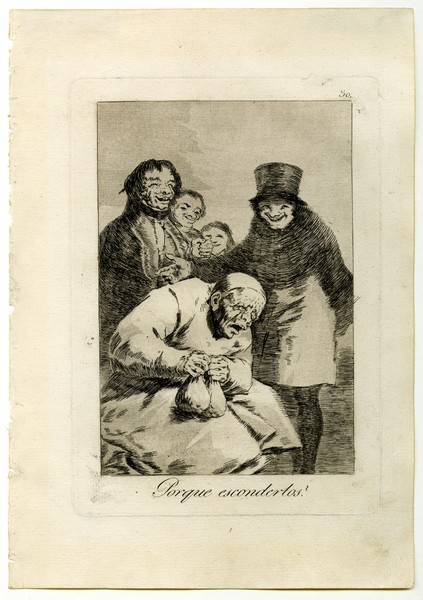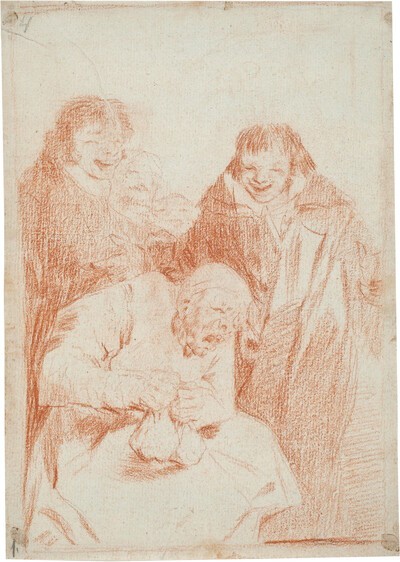- Cronología
- Ca. 1797 - 1799
- Dimensiones
- 218 x 153 mm
- Técnica y soporte
- Etching, burnished aquatint and drypoint
- Reconocimiento de la autoría de Goya
- Documented work
- Ficha: realización/revisión
- 08 Dec 2010 / 29 May 2024
- Inventario
- 225
Why hide them? (at the bottom)
30. (in the upper right-hand corner)
See Francisco de Goya y Lucientes, Painter.
There is a known status test before the letter in which the title is written in sanguine.
In the first printings the title ended in a full stop, which was later corrected by replacing it with a question mark.
Two preparatory drawings of this engraving have survived (1) and (2).
In the foreground an old miser with deformed features tries to hide, almost to protect with his bent body, two bags of coins. Next to him, slightly in the background, a man in a frock coat and top hat can be seen pointing with his hand to the left. Somewhat further back, three other figures can be seen laughing at the old man's attitude. Goya is at pains to capture the physical decrepitude of the old miser as this is, at the same time, a way of characterising him from a moral point of view.
It is possible that those to whom the situation arouses a certain hilarity are relatives of the old man, perhaps his nephews and nieces, as indicated in the interpretation of this engraving provided by the manuscripts of Ayala and the National Library, who are confidently awaiting the death of the character. These texts suggest that the subject of the image could be either a bishop or a cleric.
The Aragonese painter worked on the basis of parallel lines without delimiting the outlines of the figures, using aquatint to achieve the cohesion of the figures and to shade the different planes.
In this print Goya criticises greed, which had already been dealt with, among other cases, in Moral Dreams, Visions, and Visits of Torres with Don Francisco de Quevedo in Madrid by Diego de Torres Villarroel (Salamanca, 1693-1770).
The plate is preserved in the National Chalcography (no. 201)
-
Goya. Gemälde Zeichnungen. Graphik. TapisserienKunsthalle BaselBasle1953from January 23th to April 12th 1953cat. 220
-
Goya. La década de Los CaprichosMadrid1992organized by Real Academia de Bellas Artes de San Fernando sponsored by Fundación Central Hispano, Madrid, consultant editor Nigel Glendinnig. From October 26th 1992 to January 10th 1993cat. 176
-
GoyaNationalmuseumStockholm1994consultant editors Juan J. Luna and Görel Cavalli-Björkman. From October 7th 1994 to January 8th 1995cat. 61
-
Francisco de GoyaMuseo d'Arte ModernaLugano1996exhibition celebrated from September 22nd to November 17th.cat. 30, p.57
-
Francisco Goya. Sein leben im spiegel der graphik. Fuendetodos 1746-1828 Bordeaux. 1746-1996Galerie KornfeldBern1996from November 21st 1996 to January 1997cat. 36
-
Francisco Goya. Capricci, follie e disastri della guerraSan Donato Milanese2000Opere grafiche della Fondazione Antonio Mazzottap.28, cat. 30
-
Goya e la tradizione italianaFondazione Magnani RoccaMamiano di Traversetolo (Parma)2006consultant editors Fred Licht and Simona Tosini Pizzetti. From September 9th to December 3th 2006cat. 30, p.153
-
Goya. Opera graficaPinacoteca del Castello di San GiorgioLegnano2006exhibition celebrated from December 16th 2006 to April 1st 2007p.31
-
Goya et la modernitéPinacothèque de ParisParís2013from October 11st 2013 to March 16th 2014cat.6
-
Goya engravings and lithographs, vol. I y II.OxfordBruno Cassirer1964p.100, cat. 65
-
Vie et ouvre de Francisco de GoyaParísOffice du livre1970p.179, cat. 510
-
Goya, la década de los caprichos: dibujos y aguafuertesMadridReal Academia de Bellas Artes de San Fernando1992pp.288-289, cat. 176
-
Catálogo de las estampas de Goya en la Biblioteca NacionalMadridMinisterio de Educación y Cultura, Biblioteca Nacional1996p.90, cat. 119
-
El libro de los caprichos: dos siglos de interpretaciones (1799-1999). Catálogo de los dibujos, pruebas de estado, láminas de cobre y estampas de la primera ediciónMadridMuseo Nacional del Prado1999pp.184-187
-
ParísPinacoteca de París2013p. 64
-
Goya. In the Norton Simon MuseumPasadenaNorton Simon Museum2016pp. 42-75


